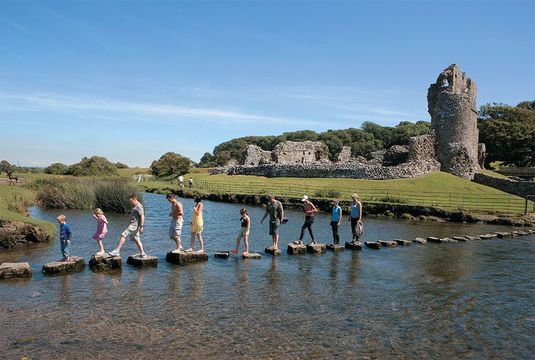
The Vale of Glamorgan
A visit to the Vale of Glamorgan is a trip through Welsh history. Join Sian Ellis as she takes a trip.
Cosmeston Medieval Village is not well known in the wider world, although some 50,000 visitors a year find their way here. It’s low-key, but lively when reenactments are going on. The real interest lies in the historic authenticity of the site and the chance to witness archaeological investigation working alongside the visitor attraction.
“There’s no evidence of a church or mill, just a street, and, although we’ve got a huge archive of animal bones, we’ve found no human burials here, which is strange,” says Jane Stewart, project officer of the archaeological dig. “We think it was an important and large settlement, but why, if it was simply a typical village supplying the manor house?” One suggestion is that it supplied Cardiff Castle, half a dozen miles to the north.
“Pottery from Spain, France, Devon, Cornwall and Bristol show there was trade with the coast—the Bristol Channel is less than a mile away,” Stewart adds. “A lot of routes seemed to converge here. But what happened to the village in later centuries?”
Such are the puzzles that inspire archaeologists to dig into the past. Traces of Cosmeston Medieval Village came to light by chance in the late 1970s, when the Vale of Glamorgan Borough Council began turning a derelict quarry into more than 200 acres of lakes and country park where wildlife and people can enjoy themselves in equal measure. So exciting was this rare discovery that a unique heritage project was set up, using archaeological evidence to reconstruct a village dated 1350 on the site of the original. There are thatched buildings, gardens and rare breeds, plus a homespun museum where I met Stewart. Nearby, students from Cardiff University were painstakingly scraping at the buried walls of the original manor house. It’s a real community project.
“There’s so much more of the village to explore,” Stewart says, adding a little wistfully, “we come in summer to dig and then retreat in winter to catalogue finds and apply for more funding.”
I joined one of the costumed guides around the re-created village—the medieval archer Caradog (alias assistant manager Alan Gibbon)—to hear about life for the reeve, baker, swineherd and lord. The picture he paints has been turbulent: The kings of England have imposed their rule, and Black Death has swept the land.
Cosmeston stands at the eastern end of the Vale of Glamorgan, a surprisingly underexplored area of Britain. Twenty-eight miles of coast embrace genteel seaside and watersports hotspots, startling rugged cliffs and wild sand dunes. Inland, lush green hills, fields and wooded valleys thrive with farming, pin-pricked by town and village. The M4 motorway conveniently spills visitors along the vale’s northern reaches where a history of industrial mining and iron production is now largely grassed over. But the vale is the preserve of smaller roads, castles, old sites and settlements that punctuate South Wales history—telling of Roman and Norman Conquest, powerful medieval lords, the rise and fall of coal and shipping and the gentle renaissance of the landscape as a leisure destination. There’s certainly plenty to while away a few days.
Following my medieval foray at Cosmeston, I had lunch in nearby Penarth, sitting outside at one of the restaurants along the promenade. Penarth metamorphosed from village to town when its dock was built to ship coal in the 19th century, and though the dock closed in 1963, Penarth remains the vale’s second largest town, with a population of something over 24,000. An air of Victorian and Edwardian elegance still pervades around the former homes of ship owners, coal magnates and master mariners. Their wealth left a legacy of public buildings and parks, and Windsor Gardens and the Italian Gardens on the esplanade are two reasons the town styles itself “The Garden by the Sea.”
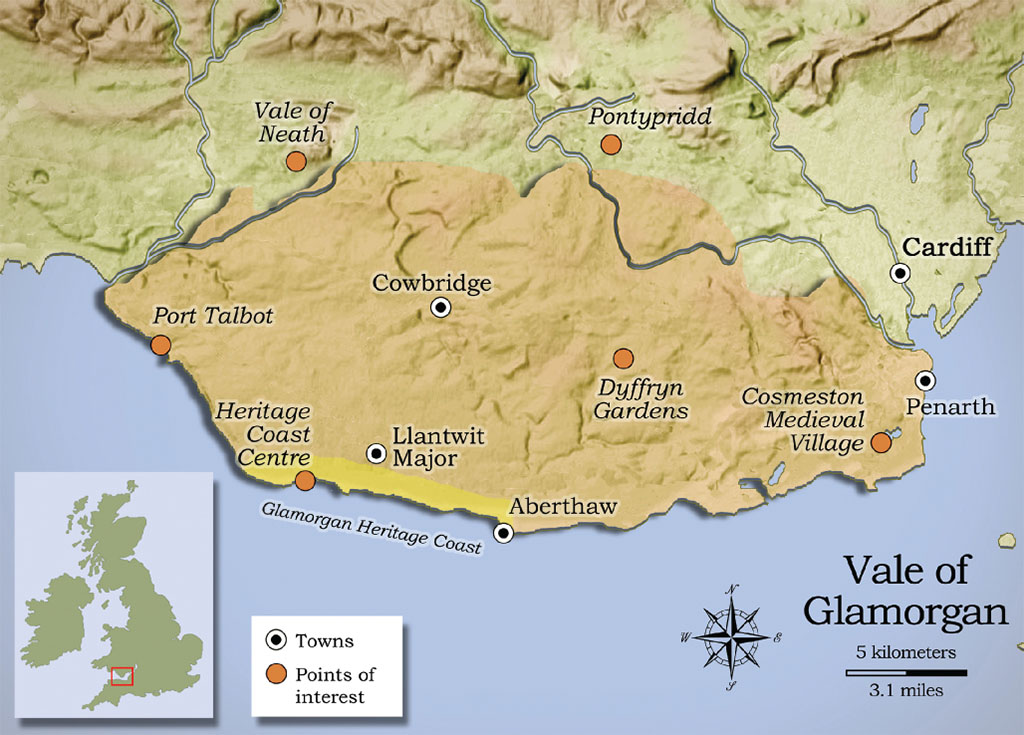
GREGORY PROCHE
I “did” the town trail, a 3.5-mile saunter (leaflets from the tourist information center beside the pier). Architectural highlights include St. Augustine’s Church, replete with 90-foot saddleback tower, unexpectedly multicolored interior and grave of Dr. Joseph Parry, composer of male voice choir favorite “Myfanwy.” It’s considered one of Britain’s finest Victorian churches. Washington Gallery of contemporary art is interestingly housed in a former cinema of Art Deco design.
But the star attractions are the pier and marina, bookends to Penarth’s fortunes. The restored grade II-listed pier, built in 1894, boasts a striking jade-roofed pavilion and is a regular berthing point in summer for the cruise ships Balmoral and Waverley—the last seagoing paddle steamer in the world. It’s a venue for indulging in some good old seaside nostalgia: ice cream in one hand, wind in hair, enjoying views to the islands of Flat Holm and Steep Holm. Brass and jazz bands play in summer. Tide in, the waves lap the esplanade; tide out, there’s a vast expanse of muddy sand.
Penarth is a bit like a dowager duchess: costumed in past grandeur but spoiled here and there by blots of ill-advised modern accessories. Some buildings are plain derelict, awaiting rescue. But in the marina—the former Victorian port—developers have got it right: attractive waterfront homes in brick and pastel colors, smart yachts and cruisers. From here you can see the giant workings of the Cardiff Bay Barrage and, if you’ve a mind, take the waterbus to the capital.
I plunged back westward, deeper into the vale to explore another of its surprises. A mile and a half down a leafy route from the village of St. Nicholas is grade I listed Dyffryn Gardens. Rooted in centuries of history, the estate came to prominence under the ownership of shipping magnate John Cory in the late 19th century. Cory created a magnificent country home for himself here, and the great landscape architect Thomas Mawson was engaged to design a suitably glorious garden—which he did in collaboration with Cory’s son, Reginald, an eminent horticulturist and funder of plant hunting expeditions, which also benefited Dyffryn.
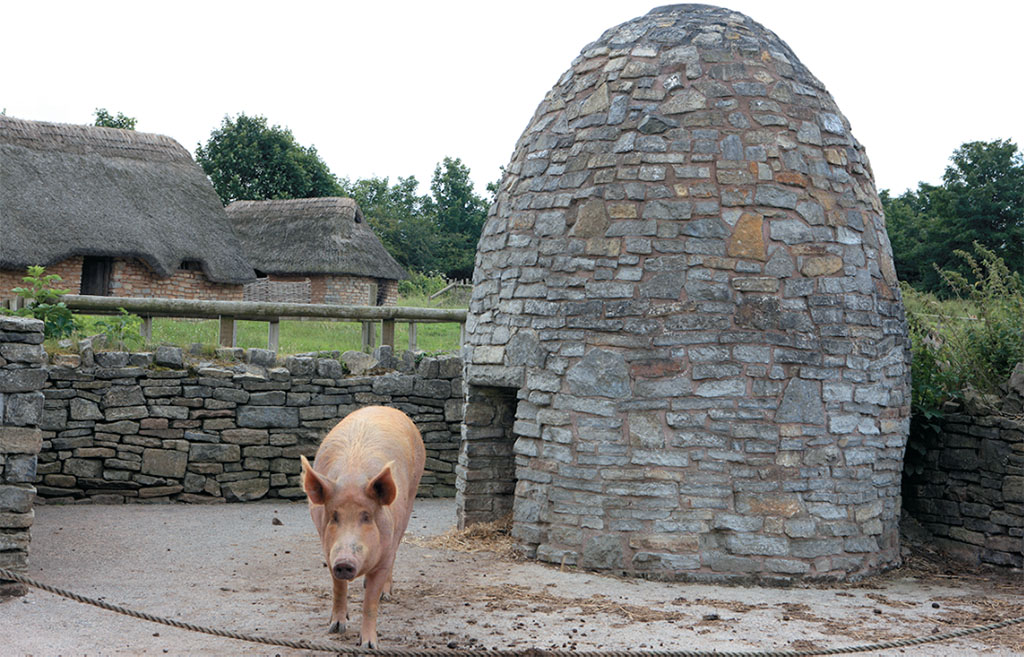
PAUL FELIX
The estate later faded, but now, managed by the Vale of Glamorgan Council, it has been undergoing an £8 million restoration in keeping with its Edwardian heritage. It should have been finished, but as project manager Gerry Donovan wryly told me, there have been a few holdups.
“Environmental legislation to protect certain species means we could not work on water features when the great crested newts were in the water for breeding. And when they hibernate, we can’t move stones that might disturb them. If you do, there’s a £20,000 fine per newt!”
Roosting bats, water vole surveys and the need to build ramps into pools for the hedgehogs that might carelessly drop in have all added to the fun of restoration. “We’re happy to coexist,” Donovan insists. “Heritage gardens have some of the best biodiversity.”
It’s already a fantastic garden again, reviving Mawson’s trademark arrangement of stately formality near the house, progressing through more intimate scenes to merge with the surrounding countryside. There are 55 acres and more than 30 themed areas: lawns where Dyffryn Croquet Club plays, an exceptional arboretum, champion trees, fernery, statuary, garden “rooms” from the Mediterranean to Theatre, Physic to Pompeian and Rose. With such variety, there’s something to see all year round and the atmosphere flits from open and airy to secluded and hidden.
If you fancy a traipse into the mysterious past, Tinkinswood Burial Chamber is across fields from the road back to St. Nicholas. The 40-ton capstone over the cavern would have required 200 people to lift when it was built around 4,000 BC. The presence of modern electricity pylons in the fields notwithstanding, rustling trees, bird calls and watching foxgloves all conspire to give an eerie vignette. The bones of at least 40 Neolithic folk have been found here (knocking Cosmeston into a cocked hat) and the ubiquitous King Arthur is fancifully connected to the site.
On along the A48, the market town of Cowbridge is worth a dally for its distinctive main street of tall, short, fat and thin buildings in cheerful, multicolored pastels and stone. Individual shops (fashions to antiques), pubs, wine bars and restaurants vie with the historic town hall and re-created physic garden for attention.
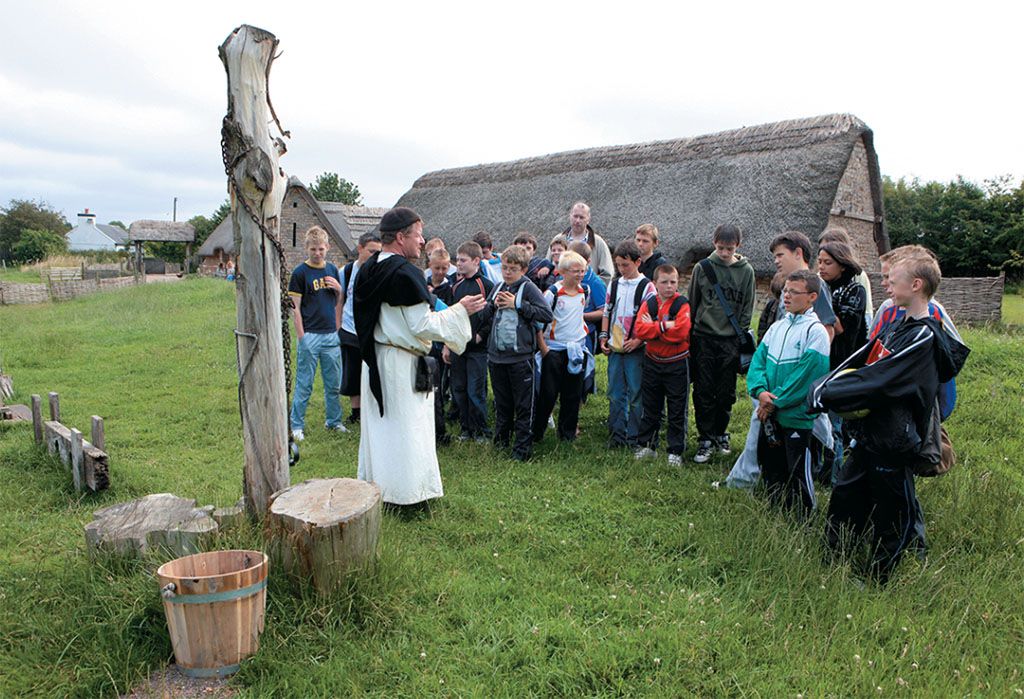
Glamorgan
But an even greater draw is to the south, back down near the coast at the town of Llantwit Major: the great church of St. Illtud, or, in Welsh, Llanilltud Fawr. The church in question stands prettily beside the Ogney Brook, close to the square. Today’s building is largely medieval, built and rebuilt over the centuries as befitted a prosperous agricultural town. St. Illtud first founded a famous monastery and church here circa AD 500, as well as a school that claims to be the oldest seat of learning in Britain. If you don’t know St. Illtud, speak to the Rev. John Webber or other locals, who will tell you that he should have been a candidate for patron saint of Wales instead of David.
“In historical terms, Llantwit Major is certainly the equal of Iona or Lindisfarne, but in the Middle Ages we never had the kind of backing to make it a major pilgrimage site,” Webber says. “Nor have we had the kind of people to really push it forward in modern times, but we’re trying to redress that now. Its historical importance is immense.”
The story of Illtud, possibly a Breton or a soldier, is certainly compelling: His school, church and monastery gave Llantwit Major a reputation as a shining outpost of learning and Christianity following the departure of the Romans. Saintly pupils included Samson and Paul Aurelian; Gildas, who wrote the first book on Welsh history, also studied here. The 7th-century Life of St. Samson tells us:
“Illtud was of all the Britons the most accomplished in all the Scriptures, namely the Old and New Testaments, and in those of philosophy of every kind, of geometry namely, and of rhetoric, grammar and arithmetic, and of all the theories of philosophy. And by birth he was a most wise magician, having knowledge of the future.”
On the summer’s day I arrived, just after morning Eucharist, I had coffee warmly pressed into my hands and was shown the church’s rare treasures. Members of the congregation or local history enthusiasts will happily show anyone around; call 01446795551. The building may be fairly plain, but it boasts intricately carved Celtic crosses, medieval wall paintings, a 13th-century Jesse Niche and a pre-Reformation altar. Not to mention a tombstone declaring a former vicar lived from 1405 to 1534, which is a ripe old age. There are plans to develop facilities to interpret the Celtic stones—all that’s needed now is funding.
The historic heart of Llantwit Major is beguiling. Tudor buildings around the square rose when the town had to be repaired following the early 15th-century rebellion of Owain Glyndwr. The Old White Hart and Old Swan Inn make civilized refreshment stops—the latter was a favorite of American visitors before World War II when nearby St. Donat’s Castle was owned by William Randolph Hearst. The visitor information center under the steps of the town hall is a trove of maps and walks; narrow lanes and roads hugged by gray-brown or pastel cottages lead off to all sorts of charming vistas; and squealing seagulls remind you that Glamorgan Heritage Coast is a just few minutes away.
Stretching 14 miles from Aberthaw in the east to Newton Point in the west, the Heritage Coast was so designated in the early 1970s in recognition of its outstanding natural beauty and geology: tall, layered cliffs of limestone and shale split by small, deep valleys; wave-cut platforms; sand dunes and a majestic inter-tidal area created by the second highest tidal range in the world. Join the coastal strip from Llantwit Major, around a quarter of the way along, and the drive is exhilarating—a shifting kaleidoscope of open roads to big skies, high-hedged lanes promising pubs and villages, sheep-speckled verges, drystone walls, yawning sands and whaleback hills.
Visiting the Vale of Glamorgan and Glamorgan Heritage Coast
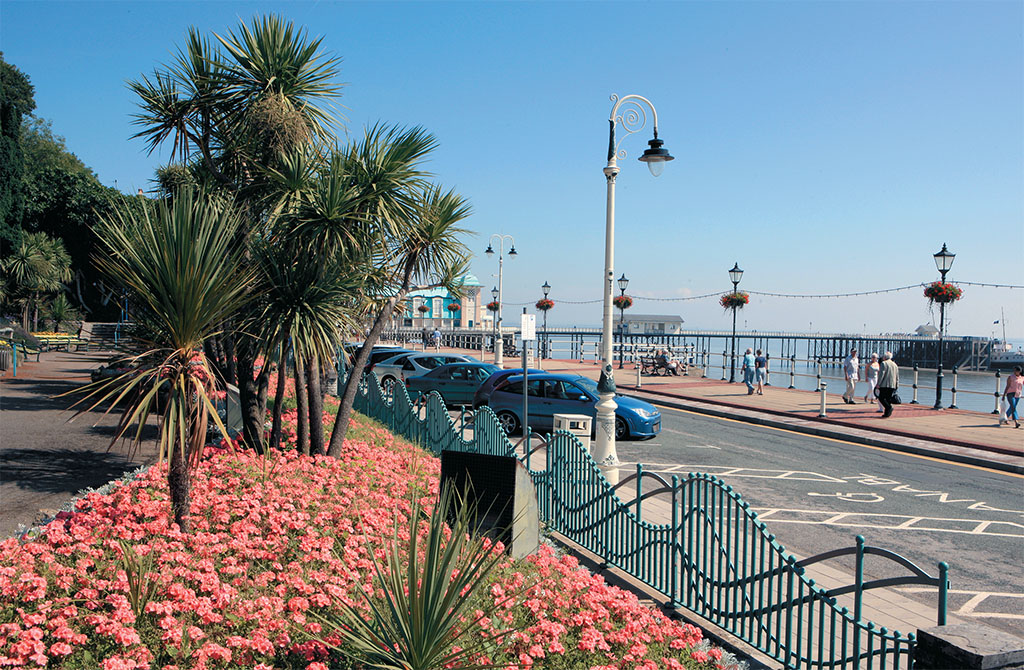
PAUL FELIX
The Heritage Coast Centre at Dunraven Park, Southerndown, exhibits the area’s geology and history—from Romans and Viking raids, through tales of wealthy shipwreckers, to the present. It’s also a good location for a picnic, and I shared a pot of tea with Paul Dunn, principal ranger for the Glamorgan Heritage Coast Project that’s based here. Dunn and three fellow rangers manage the coastline in conjunction with helpful local landowners, to conserve its character and encourage sustainable recreation. Here’s a man who loves his job, though he never quite knows when he arrives each morning whether he’ll be dealing with a sightseeing school party or a storm-induced rockfall.
“The variety of the job is one of the attractions,” he laughs. “It’s a dynamic coastline, always being nibbled. Winter is spectacular, with terrific winds funneling up the valleys. Some Sundays after lunch you can get 500 cars here, all locals come to walk and blow away the cobwebs.” How the Brits love doing battle with the seaside elements. In fact, Dunn says, around 90 percent of visitors are locals; so few people from farther afield have discovered the area. Amazing. The diverse coastal habitat is home to more than 30 species of butterfly, including the whimsically named grizzled skipper; rare birds like choughs and striking flora from thrift to golden samphire. Leaflets aplenty highlight country hikes and the awesome natural theater.
The coast is also home to salty tales of smugglers and ghosts. Hear the wind growling? It’s probably the Cyhiraeth, an invisible harbinger of death that prowls the shores. Drive still farther west to the remains of 12th-century Ogmore Castle: Here a phantom White Lady wreaked revenge on the thief of her treasure. Get your timing right with the tides and you can hop over the stepping-stones across the river to Merthyr Mawr, a Thomas Hardyesque scattering of cottages in woodland, one or two of which offer afternoon tea in the garden.
Merthyr Mawr sand dunes once hosted scenes for the film Lawrence of Arabia. Even more interesting is the claim that the lost settlement of Treganllaw (English translation: “the town of a hundred hands”) lies buried beneath the dramatic sands. Only the haunted ruins of 15th-century Candleston Castle survive. Maybe the archaeologists of Cosmeston should come and take a look. Or maybe some things are better left as a teasing mystery.





Comments